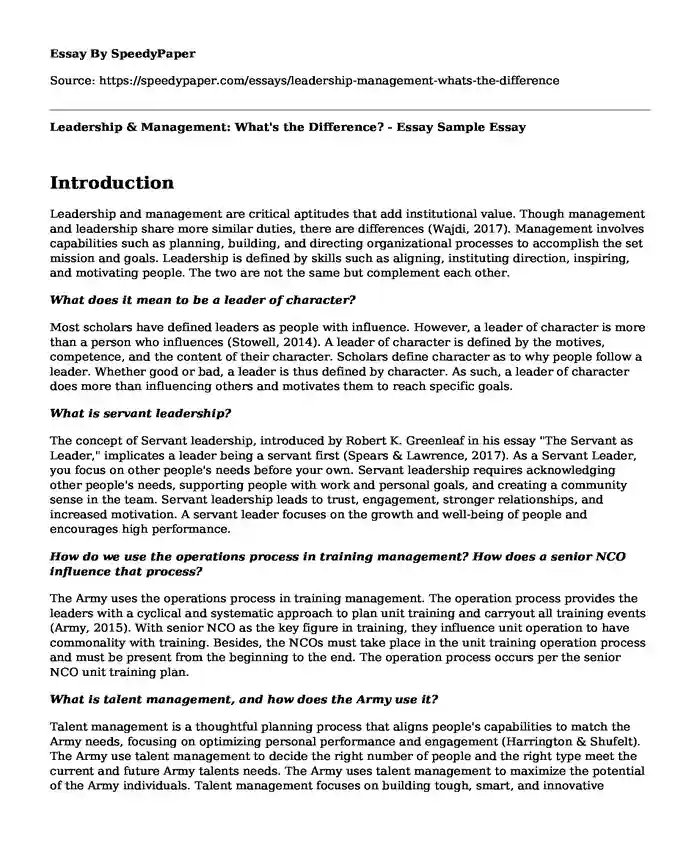
| Type of paper: | Essay |
| Categories: | Leadership analysis Management Government Army |
| Pages: | 3 |
| Wordcount: | 610 words |
Introduction
Leadership and management are critical aptitudes that add institutional value. Though management and leadership share more similar duties, there are differences (Wajdi, 2017). Management involves capabilities such as planning, building, and directing organizational processes to accomplish the set mission and goals. Leadership is defined by skills such as aligning, instituting direction, inspiring, and motivating people. The two are not the same but complement each other.
What does it mean to be a leader of character?
Most scholars have defined leaders as people with influence. However, a leader of character is more than a person who influences (Stowell, 2014). A leader of character is defined by the motives, competence, and the content of their character. Scholars define character as to why people follow a leader. Whether good or bad, a leader is thus defined by character. As such, a leader of character does more than influencing others and motivates them to reach specific goals.
What is servant leadership?
The concept of Servant leadership, introduced by Robert K. Greenleaf in his essay "The Servant as Leader," implicates a leader being a servant first (Spears & Lawrence, 2017). As a Servant Leader, you focus on other people's needs before your own. Servant leadership requires acknowledging other people's needs, supporting people with work and personal goals, and creating a community sense in the team. Servant leadership leads to trust, engagement, stronger relationships, and increased motivation. A servant leader focuses on the growth and well-being of people and encourages high performance.
How do we use the operations process in training management? How does a senior NCO influence that process?
The Army uses the operations process in training management. The operation process provides the leaders with a cyclical and systematic approach to plan unit training and carryout all training events (Army, 2015). With senior NCO as the key figure in training, they influence unit operation to have commonality with training. Besides, the NCOs must take place in the unit training operation process and must be present from the beginning to the end. The operation process occurs per the senior NCO unit training plan.
What is talent management, and how does the Army use it?
Talent management is a thoughtful planning process that aligns people's capabilities to match the Army needs, focusing on optimizing personal performance and engagement (Harrington & Shufelt). The Army use talent management to decide the right number of people and the right type meet the current and future Army talents needs. The Army uses talent management to maximize the potential of the Army individuals. Talent management focuses on building tough, smart, and innovative leaders who can work on intricate environs. The current US Army uses Talent management to transform business practices, enhance the current Army management practices, and build up the strongest Army.
What are the transition points, and how do they relate to management al all echelons?
Transition points are extraordinary, unconventional points used in the Army to guide promotion from one echelon level to the next. Transition points are used to shift from one level of management to the next. Transformational leadership has been the key observed in all levels of management, which require transition points. Transitional points relate to echelons as transformational leadership can be shifted across all hierarchy of the echelons.
Reference
Army, U. S. (2015). Noncommissioned officer guide. TC, 7-22.
Harrington, C. B. J., & Shufelt, J. W. Transforming US Army Talent Management
Spears, L. C., & Lawrence, M. (Eds.). (2016). Practicing servant-leadership: Succeeding through trust, bravery, and forgiveness. John Wiley & Sons.
Stowell, J. M. (2014). Redefining leadership: Character-driven habits of effective leaders. Zondervan.
Wajdi, B. N. (2017). The differences between management and leadership. Sinergi: Jurnal Ilmiah Ilmu Manajemen, 7(1).
Cite this page
Leadership & Management: What's the Difference? - Essay Sample. (2023, Oct 15). Retrieved from https://speedypaper.net/essays/leadership-management-whats-the-difference
Request Removal
If you are the original author of this essay and no longer wish to have it published on the SpeedyPaper website, please click below to request its removal:
- Free Essay: How the Performance of a Team Is Influenced by the Transformational Leadership
- Essay Sample on Eugene Debs Speech
- Essay Sample on a Contemporary Healthcare Issue
- Essay Sample on Amendments and Constitutional Bill of Rights
- Essay Sample on Risks and Decision Making
- Possibility of Eliminating Prisons - Free Paper Sample
- Free Essay Example on Self-reflection in Financial Management
Popular categories




